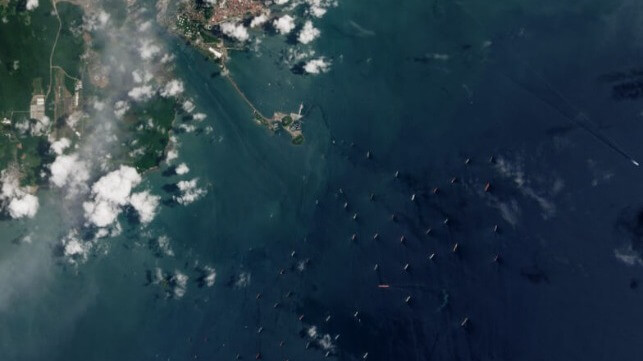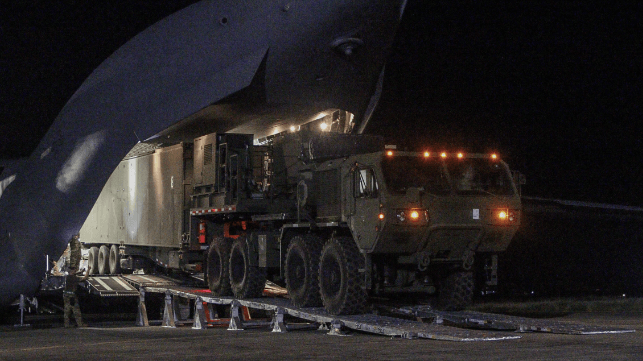Rich nations under pressure over climate finance at COP29 talks
Pressure mounted on wealthy nations Wednesday to put a figure on the table as time runs out at COP29 to strike a deal on climate assistance for poorer countries.
Issued on: 20/11/2024
By: FRANCE 24
 Developing nations say rich historic polluters have a duty to help them face the challenges caused by the climate crisis. © Laurent Thomet, AFP
Developing nations say rich historic polluters have a duty to help them face the challenges caused by the climate crisis. © Laurent Thomet, AFPAt the UN COP29 climate summit in Azerbaijan, rich nations have still not revealed how much they are ready to provide the developing world to fight climate change. UN agencies have said that developing nations, not counting China, will need $1 trillion a year by the end of the decade to meet the challenges caused by the climate crisis.
"We need a figure," said Adonia Ayebare, chair of the G77+China group of developing nations.
"Then the rest will follow. But we need a headline," the Ugandan negotiator told reporters.
Developing nations, from islands imperilled by rising seas to drought-afflicted states, contribute the least to global warming but have called for $1.3 trillion annually to prepare for its impacts.
They say rich historic polluters have a duty to help, and are clamouring for an existing commitment of $100 billion a year to be increased many times over at COP29.
Read more How lending-based climate finance is pushing poor countries deeper into debt
Talks have gone around in circles for over a week but a slimmed-down draft is expected to land in the early hours of Thursday, ensuring a sleepless night for negotiators.
"I'm sure we will have some long days and hours ahead of us ... This will be a very steep climb," EU climate commissioner Wopke Hoekstra told reporters.
Colombian Environment Minister Susana Muhamad said it was difficult to speed things up "when there's nothing to negotiate".
"The concern is that at this moment, nobody is putting a figure on the table," Muhamad said.
Rich countries on the hook for climate finance, including the European Union and United States, say they cannot show their hand until they know what they are agreeing to.
"Otherwise ... you will have a shopping basket with a price, but you don't know exactly what is in there," said Hoekstra.
"We don't just want to pluck a number from the sky," echoed Germany's climate envoy Jennifer Morgan.
China role
Developing countries, excluding China, will need $1 trillion a year in foreign assistance by 2030 to wean off fossil fuels and adapt to worsening disasters.
This number rises to $1.3 trillion annually by 2035, according to an expert economic assessment commissioned by the United Nations.
But many of the nations obligated to pay face political and fiscal pressures, and insist they cannot cover this cost on their balance sheets alone.
Developing countries want public grants from governments – not loans or private capital – to make up the majority of the new finance goal under negotiation.
Three figures – $440 billion, $600 billion and $900 billion – had been floated, said Australian climate minister Chris Bowen, one of the envoys leading the finance negotiations.
Delegates from several countries told AFP these numbers were not proposed by developed nations themselves.
"Many parties told us they need to see certain building blocks in place before they can put forward their suggested number," Bowen told COP29 delegates.
Chief among these is a demand for emerging economies such as China and Saudi Arabia, which have grown wealthy yet remain classified as developing nations, to chip into the pot.
"There are countries out in the world that have an income level that is close to or above the poorest European countries, and we think that it's only fair to ask them to contribute," Danish climate minister Lars Aagaard told AFP.
'Receding hope'
Bowen said some countries had drawn a "red line" over the type of money that could be included in any deal, insisting it come "from a wide range of sources and instruments".
Bolivia's chief negotiator, Diego Pacheco, said there was a "steadily receding hope of getting an ambitious" deal and cited $200 billion as one number in circulation.
"Only 200 billion," he told the conference. "This is unfathomable, we cannot accept this."
The lead negotiator of COP29 hosts Azerbaijan, Yalchin Rafiyev, urged countries to "pick up the pace".
"Let us embrace the spirit of collaboration, compromise and determination to ensure that we leave this conference with outcomes that make a real difference," he said.
(FRANCE 24 with AFP and Reuters)
Thank You for Emitting: The Hypocrisies of COP29
COP29 was always going to be memorable, for no other reason than the hosting country, Azerbaijan, is a petrostate indifferent to the issue of emissions and scornful of ecological preachers. It has seen its natural gas supply grow by 128% between 2000 and 2021. Between 2006 and 2021, gas exports rose by a monumental 29,290%. A dizzying 95% of the country’s exports are made up of oil and gas, with much of its wealth failing to trickle down to the rest of the populace.
The broadly described West, as stated by President Ilham Aliyev in his opening address to the Conference of the Parties to the United Nations Framework Convention on Climate Change, was in no position to be lecturing his country about cutting back on the use of fossil fuels. They were, he grandly claimed, “a gift from God”. In this, he should have surprised no one. In April 2024, he declared that, as a leader of a country “which is rich in fossil fuels, of course, we will defend the right of these countries to continue investments and to continue production.”
A few days later, Aliyev played the other side of the climate change divide, suggesting at a meeting with island leaders that France and the Netherlands had been responsible for “brutally” suppressing the “voices” of communities in such overseas territories as Mayotte and Curaçao concerned with climate change. (Aliyev himself is no stranger to suppressing, with dedicated brutality, voices of dissent within his own country.) This proved too much for France’s Ecological Transition Minister, Agnès Pannier-Runacher, who cancelled her planned attendance to the summit while attacking Baku for “instrumentalising the fight against climate change for its undignified personal agenda.”
On the second day of the summit, the UN Secretary-General, Antonio Guterres, tried to turn the attention of delegates to the urgent matter at hand. “The sound you hear is the ticking clock – we are in the final countdown to limit global temperature rise to 1.5°C, and time is not on our side.” Others, however, heard the sound of money changing hands, with the fossil fuel industry lurking, fangs and pens at the ready, presided over by the good offices of a petrostate.
In the background lie assessments of gloomy inevitability. The Climate Change Tracker’s November 2024 briefing notes this year was one characterised by “minimal progress, with almost no new national climate change targets (NDCs) or net zero pledges even though government have agreed to (urgently) strengthen their 2030 targets and to align them with the 1.5°C goal of the Paris Agreement.”
As easy as it is to rage against the opportunistic Aliyev, who crudely blends environmentalism with ethnic cleansing, few attending the summit in Baku come with clean hands. As with previous COP events, Baku offers another enormous event of emitters and emission, featuring tens of thousands of officials, advisors and minders bloviating in conference. That said, the 67,000 registrants at this conference is somewhat lower compared with the 83,000 who descended on Dubai at COP28.
The plane tracking website FlightRadar24 noted that 65 private jets landed in the Azerbaijani capital prior to the summit, prompting Alethea Warrington, the head of energy, aviation and heat at Possible, a climate action charity, to tut with heavy disapproval: “Travelling by private jet is a horrendous waste of the world’s scarce remaining carbon budget, with each journey producing more emissions in a few hours than the average person around the world emits in an entire year.”
COP29 is also another opportunity to strike deals that have little to do with reducing emissions and everything to do with advancing the interests of lobby groups and companies in the energy market, much of it of a fossil fuel nature. In the spirit of Dubai, COP29 is set to follow in the footsteps of the wily Sultan Ahmed Al Jaber, who chaired COP28 in Dubai. Prior to the arrival of the chatterati of climate change last year, the Sultan was shown in leaked briefing documents to the BBC and the Centre for Climate Reporting (CCR) to be an avid enthusiast for advancing the business of the Abu Dhabi National Oil Company (Adnoc). It was hard to avoid the glaring fact that Al Jaber is also the CEO of Adnoc.
The documents in question involve over 150 pages of briefings prepared by the COP28 team for meetings with Jaber and various interested parties held between July and October this year. They point to plans to raise matters of commercial interest with as many as 30 countries. The CCR confirms “that on at least one occasion a nation followed up on commercial discussions brought up in a meeting with Al Jaber; a source with knowledge of discussions also told CCR that Adnoc’s business interests were allegedly raised during a meeting with another country.”
The COP29 chairman, Samir Nuriyev, had already put out feelers as early as March this year that a “fair approach” was needed when approaching countries abundant with oil and natural gas, notably in light of their purported environmental policies. He went so far as to argue that Azerbaijan was an ideal interlocutor between the Global South and Global North. His colleague and chief executive of the COP29 team, Elnur Soltanov, showed exactly how that process would work in a secret recording ahead of the conference in which he discusses “investment opportunities” in the state oil and gas company with a person posing as a potential investor. (The person in question purported to be representing a fictitious Hong Kong investment firm with a sharp line in energy.) “We have a lot of gas fields that are to be developed,” Soltanov insists. “We will have a certain amount of oil and gas being produced, perhaps forever.”
In many ways, the Baku gathering has all the hallmarks of a criminal syndicate meeting, held under more open conditions. Fair play, then, to the Azerbaijani hosts for working out the climate change racket, taking the lead from Dubai last year. Aliyev and company noted months in advance that this was less a case of being a theatre of the absurd than a forum for business. And so, it is proving to be.



